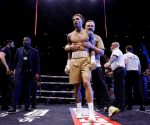How the Suns are turning the page on the Kevin Durant era — and enjoying unexpected success in the process
When Mat Ishbia initiated the trade for Kevin Durant literal hours after buying the Suns, he had visions of championship banners dancing in his head. When Phoenix shipped Durant to Houston 28 months later — after a tumultuous tenure that included more fired head coaches (three) than playoff series wins (one), the entire misbegotten Bradley Beal era and well over $ 200 million in luxury tax payments — the franchise felt bereft, so far adrift from relevance that it could no longer see the shore, with arguably the NBA’s grimmest future outlook.
Thanks to the Durant and Beal trades, the Suns don’t control their own first-round draft pick for the next seven years. Thanks to the decision to use the stretch provision to waive the balance of Beal’s gargantuan salary, they’ll also have an unmovable $ 19.4 million roster charge on their salary cap sheet through 2030. Those bills are still coming due; the path back to contention still looks murky at best, and impassable at worst.
With all those picks out the door and all that money already spent, though, all the current iteration of the Suns can do is take the first steps down that path. And … they’re kind of kicking ass at that?
CELEBRATE WITH THE GUYS 👀 pic.twitter.com/xSYLdJMSHh
— Phoenix Suns (@Suns) November 22, 2025
After staging a stunning late comeback to knock off the Timberwolves in Emirates NBA Cup play on Friday and taking down the Victor Wembanyama-less Spurs on Sunday, the Suns have won three straight and eight of their last nine, sitting at 11-6 on the season. Phoenix enters Monday’s matchup with the Rockets — a contest that lost a bit of zing when news broke this weekend that Durant would miss the game while tending to a family matter — just a half-game behind Durant’s Rockets for the No. 4 spot in the Western Conference, and just a game and a half behind Luka Dončić’s Lakers and Nikola Jokić’s Nuggets for the second seed.
This, to put it mildly, is not how most prognosticators saw the Suns coming out of the gates after trading away two huge pieces, hiring a new general manager who’d spent virtually his entire career in college basketball (Brian Gregory) and yet another new head coach (former Cavaliers assistant Jordan Ott), and reforming the 2024 Hornets’ center rotation. It is, however, pretty much exactly the kind of team that Ishbia envisioned pivoting toward after his attempt to microwave a winner so spectacularly flamed out.
“After last season, we said, ‘That old stuff that we did? It didn’t work,'” Ishbia told reporters at Suns media day. “Let’s get it done the right way. Let’s build an identity. … I don’t have a game total that we’re going to win, but I do think the expectations are a team that we’re proud of, a team that plays hard, a team that competes, a team that’s getting better and is fun to watch.”
That’s precisely what these Suns have been through the opening weeks of the season: a team that plays a tough, physical, relentless brand of basketball, an approach that starts with a commitment to getting stops.
Suns' new identity
Under Ott, Phoenix has jumped on the post-Pacers league-wide trend of picking opponents up the length of the floor. After dialing up full-court pressure on just on 1.5% of their defensive possessions last season, according to Synergy Sports, the Suns are pressing 5.8% of the time this season, the seventh-highest rate in the league. As a result, they’ve seen one of the league’s largest jumps in average pick-up distance, according to NBA.com’s John Schuhmann.
The full-court pressing is “one way for me to stick in the league,” Suns guard Collin Gillespie recently told Logan Murdock of The Ringer. “I got to play hard. I got to compete. That’s probably my calling card as an NBA player.”
(Being willing to take on the taxing dirty work of guarding the full 94 might’ve helped get Gillespie’s foot in the door, but what he’s showing in the rest of his game is kicking that sucker off the hinges. The third-year Villanova product is averaging 11.4 points, 5.1 assists and 4.2 rebounds in 25.3 minutes per game off the bench, shooting 40.6% from 3-point range on more than six attempts per game. He’s dished 87 assists against 26 turnovers this season — a top-20 assist-to-turnover ratio among rotation players who’ve made at least 10 appearances — and just dropped a game-winning pull-up dagger to beat Minnesota. He’s not just a hustle player. He’s a player.)
Aggressive backcourt pickups, hard doubles in the post, in-your-jersey ball pressure, hands in the passing lanes while tracking cutters: These Suns want to man up, get in your face as early, as often and as physically as possible, and make you feel them on every possession. Despite frequently being at a size disadvantage across multiple positions — Brooks, Royce O’Neale and Ryan Dunn, all listed at either 6-foot-6 or 6-7, take the bulk of the power forward minutes, while backcourt rotation members Gillespie, Grayson Allen and Jordan Goodwin all measure 6-4 or under — the Suns swarm, do their work early to push larger opponents off their spots in the post, crack back on the defensive glass, force you to make plays through thickets of arms and legs.
They no longer feel like the laissez faire team that employed Durant and Beal. They now feel, frankly, like the one that employs Dillon Brooks, who helped shepherd (sometimes overly) aggressive defensive overhauls in Memphis and Houston, and is now doing the same in Phoenix.
“He’s one of the hardest workers I’ve been around,” Suns superstar Devin Booker said of Brooks, one of the key pieces that came to Phoenix in the Durant trade, alongside high-scoring guard Jalen Green (working his way back from a hamstring injury) and No. 10 overall draft pick Khaman Maluach. “He spends countless hours — even when he was going through his core injury, I was telling him, ‘You supposed to be going that hard?'”
Whether he’s supposed to or not, Brooks does go that hard — and now, so, too, do the Suns. (Fun stat: Phoenix is tied for seventh in loose balls recovered per game, up from 20th last season.) Occasionally, all that physicality is to their detriment: Phoenix has been whistled for 23.7 personal fouls per game, second-most in the NBA, and sits 24th in opponent free throw rate.
“We’re not going to be a low-foul team,” Ott recently said, according to Kellan Olson of Arizona Sports. “We’re going to defend to the legal limit [and] we know that comes at a cost.”
But that cost, thus far, hasn’t outweighed the benefits. The refs can’t call everything, and setting that sort of physical defensive tone — with Brooks, O’Neale and Dunn up front and on the wing, with Gillespie and Goodwin at the point of attack — can pay dividends that compound over the course of the game. And so far, the results have been impressive.
The Suns have been *flying* around defensively this quarter
A great shift in activity & sharpness on that end — Blazers with just 19 points this period, with a minute left https://t.co/W7xvyc4TfQpic.twitter.com/GGQWfMFBOj
— Stephen PridGeon-Garner 🏁 (@StephenPG3) November 19, 2025
After finishing 27th in points allowed per possession last season, Phoenix enters Monday ranked eighth, according to Cleaning the Glass. The Suns are second in the NBA in steals per game, behind only the league-best Thunder — including a single-game season-high 19 thefts in a win over the Trail Blazers last week — and fifth in deflections per game. They’re forcing turnovers on 16.9% of opponents’ offensive possessions — the third-highest rate in the league this season, and the highest rate of any Suns team since at least 2003.
That defense is leading to offense, too.
Suns' offense better without KD?
Phoenix ranks sixth in points off turnovers, scoring 1.41 points per possession off a steal, compared to 1.17 when they push following a defensive rebound and 0.99 against a set half-court defense.
Ott wants the Suns hitting the gas and hunting early offense whenever possible; after finishing 25th in average time to shot last season, Phoenix sits fifth so far this season, according to Inpredictable, firing one up within 10.9 seconds of having the ball. The whole team is operating with a let-it-fly mentality, especially from 3-point land: Nearly 41% of Phoenix’s shots have come from beyond the arc, a top-10 rate, with multiple Suns hoisting long balls at career-high frequency.
Allen has the greenest light of his eight-year career to fire off the dribble, and he’s taking full advantage, launching nearly 10 triples per 36 minutes and drilling them at a 44.7% clip on his way to a career-high 18.5 points and 4.3 assists per game. O’Neale, long one of the league’s more dependable 3-and-D wings, is at 43.5% from distance on nearly nine attempts per-36.
Brooks hasn’t been nearly as accurate, shooting just 34.1% from deep, but he has looked very comfortable in a larger offensive role, finishing 28.2% of Phoenix’s offensive possessions with a shot attempt, foul drawn or turnover — a jump of more than 10% from his usage rates in Houston — and shooting at career-best rates inside the arc en route to 21.4 points per game.
“Yeah, this game is all about confidence,” Brooks said, according to Olson. “No matter what level it is, you gotta be confident in your game.”
Booker has never lacked confidence in his game. After an up-and-down 2024-25 season that saw him play through some groin and back issues amid the vibes vortex of the KD/Beal experiment circling the drain, he’s back to looking like the perennial All-NBA candidate we’d become accustomed to seeing, averaging a team-best 26.9 points and 7.1 assists per game, shooting 47.2% from the floor and 88% from the foul line:
With Booker firmly at the controls on the ball — an estimated 60% of his minutes have come while functioning as Phoenix’s point guard, according to Cleaning the Glass — the Suns have taken a jump on the offensive end, too. Phoenix enters Monday scoring 119.1 points per 100 possessions outside of garbage time, tied for seventh in the NBA.
The plan of attack looks different. Ott, who last season served as an assistant under Kenny Atkinson on Cleveland’s record-setting offense, prioritizes de-cluttering the interior: Phoenix is 26th in post-ups and 22nd in elbow touches per game, and has dropped its midrange frequency by about 4%. (Bye-bye, KD and Brad.) Making sure the floor is properly spaced — shooters stationed deep in each corner and in the slot, often with someone lurking in the dunker spot for a drop-off — has helped open up dribble penetration, with the Suns ranking 13th in drives per game (up from 20th last season) and seventh in assists off forays to the basket.
[Get more Suns news: Phoenix team feed]
With Booker, Allen and revelation backup point guard Gillespie consistently getting downhill and looking to spray the ball out to the perimeter, the Suns rank third in the NBA in points scored per possession on spot-up shots, according to Synergy. With multiple Suns shooting the cover off the ball off those kickouts, they have the third-highest team effective field goal percentage (which accounts for 3-pointers being worth more than 2-pointers) on catch-and-shoot looks, according to Second Spectrum. Combine that with an increased emphasis on pounding the offensive glass — fourth in the NBA in offensive rebounding rate and 10th in second-chance possessions per game — and strong finishing on the interior, and you’ve got the recipe for what is, kind of hilariously, on pace for a better offensive finish than any KD-era Suns team.
There have been hiccups: a loss in Utah where the Suns gave up an 8-1 run in the final two minutes of overtime; a one-point defeat to the Grizzlies in one of the rare highlights of Ja Morant’s season to date; that disastrous loss to the Hawks in which Phoenix blew a 22-point lead in the fourth quarter. And there are caveats: chiefly, that the Suns have played one of the NBA’s softest opening slates, with 10 home games against seven road contests, headlined by a recent five-game stretch that began with a home-and-home against the Clippers before taking on the Pelicans, Mavericks and Pacers.
Conversely, they have one of the league’s toughest remaining schedules, which starts getting rough right about … now. Between Monday and Christmas, the Suns will have to face the Rockets, Lakers and Warriors twice, in addition to meetings with the Thunder, Nuggets and Wolves; by Boxing Day, we should have a much better sense of just how serious these Suns really are.
Considering how deeply unserious many thought Phoenix was after Ishbia’s failed attempt to speed-run a titlist, though, these first few weeks represent a mammoth sea change in how we must consider the Suns. If, as my pal Paul Flannery used to say, the best time you can have in the NBA is right before you get good, perhaps the second best time is when, after being dreadfully unfun, you start to rediscover a spark of joy.
The picks are dealt, the money’s spent, and you have — reasonably, I think, from both a talent and “recognizing your organizational saints” perspective — tied yourself to Booker for as much and as long as possible. So: what do you do? Try to refresh the culture, try to establish an identity, try to rebuild the trust with your fan base, and try to make the experience of watching your team play fun again. That’s where the Suns are right now. And after two years of slogging and spiraling, that ain’t nothing.










